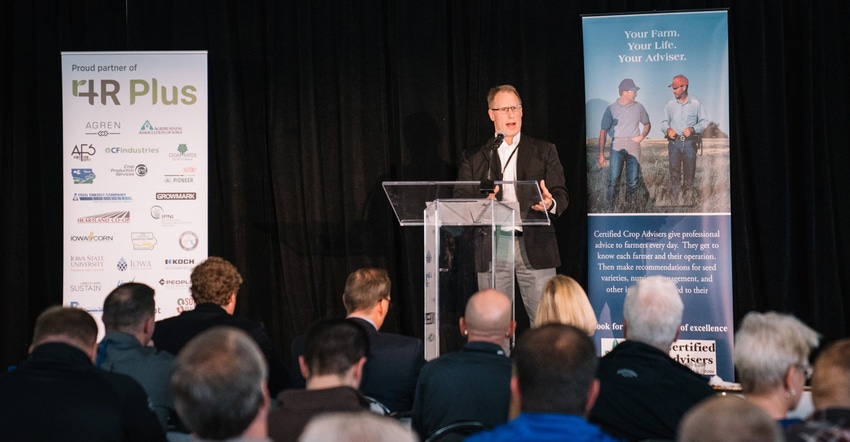
A coalition of ag and conservation stakeholders launched the 4R Plus campaign earlier this year to raise awareness about practices to improve soil productivity, soil health and water quality.
The “4R” stands for the four R’s of nutrient stewardship – right rate, right place, right source and right. The “Plus” includes in-field and edge-of-field conservation practices, such as cover crops and reduced tillage. The combined use of these practices can increase production and efficiency while improving soil and water quality.
The 4R Plus campaign was launched in Iowa at the Agribusiness Association of Iowa’s 2018 Showcase event — an annual gathering of the state’s fertilizer and chemical dealers, certified crop advisers, and related ag businesses. The two-day meeting in Des Moines in February was filled with well-attended educational sessions on timely topics.
Keeping soil healthy
4R Plus is a nutrient management and conservation education program that equips farmers with tools and resources to protect and enhance soils. The tools and resources have been available, and now 4R Plus brings all the players together by encouraging a team effort.
“CF Industries along with The Nature Conservancy came together with a vision for a program that would empower Iowa farmers and their efforts to improve soil health,” says Tony Will, president and CEO of CF Industries.
Support for the program has expanded to include 30 organizations: state commodity groups, agribusinesses, conservation organizations, government agencies, universities and others. “We all have the same goal,” Will says. “That is to build upon the good work farmers are doing and provide them with more tools and resources to help implement practices that enhance crop growth and boost yield potential and return on investment while safeguarding some of the best soil in the world.”
4R nutrient stewardship
4R nutrient stewardship goes beyond on-farm sustainability benefits, says Greg Wandrey, Iowa agriculture program director for The Nature Conservancy and coordinator of the 4R Plus program. Using the 4Rs can improve production and farmer profitability while enhancing environmental protection.
The Fertilizer Institute (TFI) recognizes the 4R Plus program as a way for farmers to embrace the 4Rs. “4R stewardship is an innovative way to manage nutrients to meet a crop’s needs while minimizing nutrient losses from the field,” says Lara Moody, vice president of stewardship and sustainability programs at TFI.
Moody stresses that whether it’s the nutrient source, rate, time or place, farmers must make nutrient decisions based on information specific to their farm, soil characteristics and operational logistics. “Farmers should work with their advisers to select specific 4R practices to optimize fertilizer inputs for their individual operations,” she adds. “The 4Rs, when combined with the ‘Plus’ conservation practices, can help farmers achieve their production, economic and environmental goals.”
‘Plus’ conservation practices
With the Iowa Nutrient Reduction Strategy’s goal to reduce nitrogen and phosphorous loads in Iowa waters by 45%, farmers are looking for ways they can help. A good place to start is conservation.
Conservation practices help retain moisture, soil and nutrients, and reduce erosion and runoff, resulting in healthier soil and cleaner water. These practices are even more effective when targeted in areas with the greatest runoff, nutrient loss and soil loss.
Marty Adkins, assistant state conservationist for the Iowa Natural Resources Conservation Service, another 4R Plus collaborator, sees the need for farmer resources on conservation practices.
Soil health, water quality
“There’s a natural link between sound nutrient management and conservation practices resulting in better soil health, water quality and farmer profitability,” Adkins says. “NRCS is pleased to work with other organizations to help farmers and agronomists better understand soil health, why it’s important, and how it can be achieved.”
A good first step is to develop a conservation plan, he notes. “These plans help farmers see where they stand now and what conservation practices they need to consider. A conservation plan also can help farmers access farm programs, which can aid in the costs of implementing these practices.”
Shawn Richmond, environmental technology director for AAI, says, “Depending on the farm, there are a variety of conservation practices to consider. Cover crops and strip till or no-till are in-field practices that can minimize soil erosion and improve water infiltration, while stream buffers and wetlands act as edge-of-field filters for surface and tile water.”
A growing effort
It takes everyone working together to help farmers achieve economic and environmental success and finding the right 4R Plus practices for a field or farm is key, Wandrey says.
He adds, “The purpose of bringing these stakeholders together and ultimately the 4R Plus program is to provide consistent messages to farmers about 4R nutrient stewardship and conservation practices available for their farms. Farmers and their advisers can work together to assess economic and environmental goals, and make a plan to adopt practices that help them achieve those results.
“More than 80,000 Iowa farmers are growing food, fiber and fuel on 23 million acres. Change happens on an individual level. But if we took an all-hands-on-deck approach to nutrient stewardship and conservation practices, just think of the results we’d see.”
To learn more about 4R Plus and resources available for getting started, visit 4rplus.org.
About the Author(s)
You May Also Like




